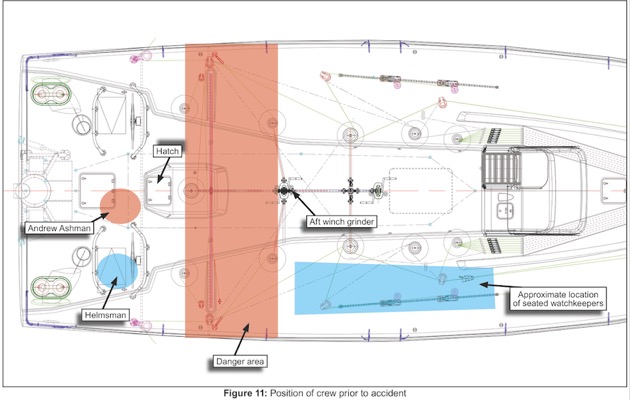How did it happen?
Although the accident occurred within the cockpit area, there were no eyewitnesses to the mechanism that led to Andrew’s fall.
The MAIB identified three different possible mechanisms leading to the injuries. Either the boom, the mainsheet (or another rope) struck Andrew Ashman during the gybes or the motion of the vessel caused him to fall against the starboard cockpit coaming.
The report concludes that it is this highly unlikely that the boom struck him as it is rigged 2m above the cockpit deck level (Ashman was 1.70m tall).
The report clearly illustrates how the danger zone is so called because of the potential for the mainsheet to pass across the area during a gybe.

‘As the boom passed from port to starboard and back again during the double unexpected gybe that led to the accident, the mainsheet would have swung across the area twice at speed, possibly catching Andrew and throwing him into the starboard deck coaming or causing him to lose balance and fall onto the deck coaming.
‘It is also possible that he was struck by the preventer line that was freed by the failure of the preventer strop. However, given the non-elastic nature of this HMPE line, any energy stored in it at the time of failure would have dissipated instantly. Consequently, the line would not have had sufficient force to cause the injuries sustained by Andrew.’
The third possible cause is that the erratic motion of vessel. ‘At the time of the gybes, Andrew was standing in the danger zone, tethered to the deck behind him with no readily available hand-holds. If he was not struck by the mainsheet, it is likely that Andrew was thrown off balance by the rapid rolling of the yacht which, possibly combined with the limiting effect of his tether, led to him falling against the starboard deck coaming.’
The report goes on to note that ‘had Andrew not taken the short-cut across the traveller, but skirted around the starboard side where both tethering points and hand-holds were readily available, this accident might have been avoided. Andrew might have been prompted to take the route prescribed during the Clipper training sessions had there been a visual reminder of the danger zone, such as visible markings on the deck.’



